October 2011
Volume 26
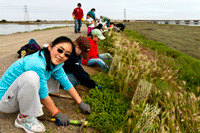
Upcoming
Events and Meetings
More events, including volunteer restoration opportunities, are listed on the Events and Meetings section of the project web site.
Stakeholder Forum Annual Meeting
October 20, 1:00 pm to 4:00 pm
Come hear the latest information about Project 2011 progress and give us your input on the next phase of restoration and public access projects, as well as designs underway for Alviso-area flood management. This meeting of the Stakeholder Form will take place at the Alameda County facility on Turner Court in Hayward. For more details and an agenda check the Events and Meetings section of the project web site.
Shorebirds Return to SF2 -
One Year Anniversary Walk
Saturday, October 22
11:00 a.m. - 12:30 p.m.
One year ago we opened the flood gates to restore a former Ravenswood salt pond near Menlo Park to tidal action. Learn what happened over this past year as we welcome the return of the shorebirds. Docent Jane Moss will lead you on a 1.5 mile round-trip walk along Don Edward's newest interpretive trail and introduce you to the South Bay Salt Pond Restoration Project. Trail is easy and level. All ages and abilities welcome. For information, please call 510-792-0222 ext. 139.
Why Tides Matter
Saturday, November 19
3:00 - 4:00 p.m.
Docent Laurel Stell will talk and walk you through all things tides. What are they? How do they affect wildlife? How have humans reshaped the Bay's tidal lands? Program starts indoors at the Environmental Education Center at Alviso but will move outside for an easy 0.5-mile walk. No reservations required.
Ethical Bird Photography
for Beginners
Saturday, December 3, 2011
Saturday, January 7, 2012
9:30 - 11:30 a.m.
Ever wanted to photograph that snowy egret stalking its dinner in the shallows? Join docent and published wildlife photographer Mark Bohrer at the Refuge's Environmental Education Center in Alviso to discover where to find those wary birds, what behavior to look for, and how to ethically capture them on pixels or film. You'll need a lens extending to at least 300mm (400mm or longer preferred) on your digital SLR, or the 35mm-equivalent on your advanced point-and-shoot camera. Tripods are recommended, but not required. Please be familiar with your camera's operation, dress for muddy conditions, and expect to do some walking. Recommended for ages 16 and up - anyone under 18 must be accompanied by a parent. Reservations required. 408-262-5513 x102.
Ravenswood Hike
Saturday, December 17, 2011
Saturday, January 21, 2012
10:30 a.m. - 12:30 p.m.
Ever wanted to photograph that snowy egret stalking its dinner in the shallows? Join docent and published wildlife photographer Mark Bohrer at the Refuge's Environmental Education Center in Alviso to discover where to find those wary birds, what behavior to look for, and how to ethically capture them on pixels or film. You'll need a lens extending to at least 300mm (400mm or longer preferred) on your digital SLR, or the 35mm-equivalent on your advanced point-and-shoot camera. Tripods are recommended, but not required. Please be familiar with your camera's operation, dress for muddy conditions, and expect to do some walking. Recommended for ages 16 and up - anyone under 18 must be accompanied by a parent. Reservations required. 408-262-5513 x102.
Winter Birds in a Restored Salt Pond
Saturday, February 11, 2012
1:00 p.m.
Bid good-bye to the overwintering shorebirds and waterfowl before they leave San Francisco Bay to return to their northern nesting grounds. Docent Jane Moss will lead you on a 1.5 mile round-trip hike along Don Edward's newest interpretive trail at Ravenswood Pond SF2 in Menlo Park and introduce you to the South Bay Salt Pond Restoration Project. Trail is easy and level. All ages and abilities welcome. Meet at the Ravenswood Point parking area on the west side of the Dumbarton Bridge. For information and directions, please call 510-792-0222 ext. 139.
Become a Friend of the Salt Ponds on Facebook
Want to receive regular updates, interesting trivia and the latest pictures and videos about the South Bay Salt Pond Restoration? Join us on Facebook.

Photo Credits: Fish species photos by Laura Valoppi, John Rusmisel photo provided by John Rusmisel; other photos by Judy Irving
|
Eden Landing Breach Opens 630 Acres to Tides
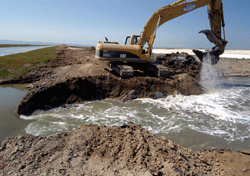 With the scrape of an excavator's bucket, a Department of Fish and Game contractor September 13 began the process of returning 630 Eden Landing acres to their origins as vegetated wetlands.
With the scrape of an excavator's bucket, a Department of Fish and Game contractor September 13 began the process of returning 630 Eden Landing acres to their origins as vegetated wetlands.
The workers completed the first of eight breaches to open three Eden Landing Ecological Reserve ponds, E8A, E9 and E8X, to the waters of Old Alameda Creek and San Francisco Bay. The milestone marks the Project's first restoration of DFG lands, and the first restoration on its East Bay acreage. With this work, the Project has opened 2,840 acres of salt ponds to San Francisco Bay waters.
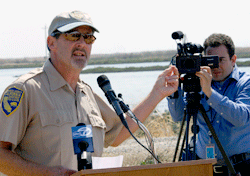 A crowd of Project managers, partners, regulators and friends cheered that day as a flood of water from Old Alameda Creek heaved across the gypsum-coated bottom of Pond E8A. Carl Wilcox, DFG Bay Delta Region Manager, spoke about the state's substantial contribution to buying the 15,100 Project acres from Cargill; it contributed $72 million of the $100 million purchase price from Proposition 40 and Proposition 50 bond funds. The Eden Landing breach construction was partly funded by stimulus funds - American Recovery and Reinvestment Act (ARRA) grants provided by the National Oceanic and Atmospheric Administration (NOAA).
A crowd of Project managers, partners, regulators and friends cheered that day as a flood of water from Old Alameda Creek heaved across the gypsum-coated bottom of Pond E8A. Carl Wilcox, DFG Bay Delta Region Manager, spoke about the state's substantial contribution to buying the 15,100 Project acres from Cargill; it contributed $72 million of the $100 million purchase price from Proposition 40 and Proposition 50 bond funds. The Eden Landing breach construction was partly funded by stimulus funds - American Recovery and Reinvestment Act (ARRA) grants provided by the National Oceanic and Atmospheric Administration (NOAA).
Click here to see video news coverage of the breach. Click here to see our YouTube video of the event.
Alviso Pond A8 Gates Opened to Slough Waters
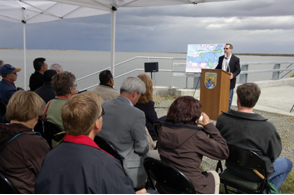 On June 1, the tidal waters of Alviso Slough flowed for the first time in decades into 1,400 acres of ponds near Alviso, when Pond A8 tidal gates were opened for the first time. Managers opened one of the eight gates at the pond, which is connected to ponds A7 and A5. Since that time, scientists have been sampling pond and slough sediments, fish and bird eggs to determine how the change in water flow is influencing methylmercury in the environment. Managers will open the gates wider, if they can do so without causing mercury problems.
On June 1, the tidal waters of Alviso Slough flowed for the first time in decades into 1,400 acres of ponds near Alviso, when Pond A8 tidal gates were opened for the first time. Managers opened one of the eight gates at the pond, which is connected to ponds A7 and A5. Since that time, scientists have been sampling pond and slough sediments, fish and bird eggs to determine how the change in water flow is influencing methylmercury in the environment. Managers will open the gates wider, if they can do so without causing mercury problems.
Click here to view video media coverage and our YouTube video of the event.
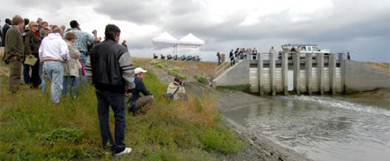
Construction upcoming at Ponds A16/17
Workers are expected in November to start the task of building nesting islands at Pond A16 and preparing Pond A17 to be breached to Bay waters.
The project will open 130 acres to the tides, as well as providing more enhanced nesting and foraging areas for shorebirds. Construction is scheduled to take two years. Once it is complete, because of levee removals to restore wetlands, the loop trail will remain, but will be shorter. An overlook platform and a fishing pier off Coyote Creek will be added for public use.
Public Input Sought on Design Options for Alviso-Area Levees
South San Francisco Bay Shoreline Study planners looking at potential levee alignments for the Alviso area presented options and heard from the public at an August 17 meeting of the Alviso Santa Clara Working Group.
Click here to view presentations and minutes from the meeting. Input from the public will be accepted through October. Another public meeting will be held in spring 2012.
Science Update: Salt Ponds Playing Host to Threatened Native Fish
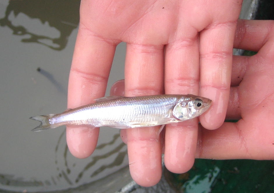
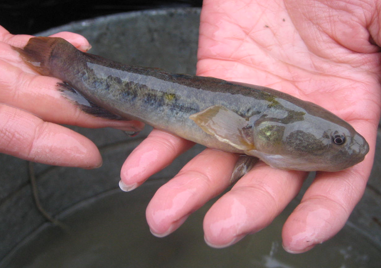
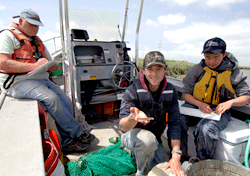 Project managers and scientists are excited by the news that the Project's newly restored salt marshes and sloughs are home to a threatened native fish, the longfin smelt (Spirinchus thaleichthys). Scientists caught 61 members of the species while sampling last December (Photo 1). The fish is listed as threatened under the California Endangered Species Act. Once common, it has experienced severe abundance declines within its range. Its abundance in the San Francisco Estuary and Delta has reached record low levels and it may be extinct in some smaller estuaries.
Project managers and scientists are excited by the news that the Project's newly restored salt marshes and sloughs are home to a threatened native fish, the longfin smelt (Spirinchus thaleichthys). Scientists caught 61 members of the species while sampling last December (Photo 1). The fish is listed as threatened under the California Endangered Species Act. Once common, it has experienced severe abundance declines within its range. Its abundance in the San Francisco Estuary and Delta has reached record low levels and it may be extinct in some smaller estuaries.
The longfin smelt is one of 30 different species of fish, most native, that have been found so far during sampling by a team lead by Dr. James Hobbs of the University of California, Davis. The Project, as part of our on-going monitoring program, is very interested in how our restoration actions affect fish populations in our project area. We have contracted with Dr. Hobbs to conduct fish surveys every other month in all three pond complexes and Outer Bair Island. The study objectives are to 1) document the fish species and communities in the newly restored salt marsh habitats and adjacent sloughs and creeks, and 2) develop indicators for evaluating fish health. We started collecting data just prior to the restoration actions, so we will have some data for "before" and "after" comparisons. All fish are released after catching, except for a small number that are collected for further analysis.
To date scientists have held six sampling outings. The results are very encouraging so far: fish are using the newly restored ponds.
At our oldest restoration site, the Island Ponds, restored to tidal flows in 2006, fish abundance is greater in the newly developing marshes and sloughs that have replaced the ponds, than in adjacent historical sloughs. This is great news, showing that restored marshes support fish communities.
Fish seem to be equally abundant in both our ponds recently restored to tidal action, and in the pond (SF2) that we have maintained and enhanced for shorebird use, indicating that fish are using newly restored areas for foraging.
Overall, more fish spend time in the project area in the summer months, as the numbers caught decrease in the fall. Northern anchovy and three-spine stickleback were the most abundant species found in the project area in summer. In the winter, a different suite of species predominate - joining stickleback as most abundant are topsmelt, Pacific herring, longfin smelt, and speckled sanddab. These different fish assemblages are likely the result of changes in temperature and salinity with season.
Another part of the study is to track the health of longjaw mudsuckers (Gillichthys mirabilis) by capturing, tagging and recapturing them (Photo 2), as well as gathering data on their growth. This species is most abundant in Alviso Slough fringing marshes.
In October 2010, scientists observed a fish kill in the upper reaches of Coyote Creek and Alviso Slough, which was associated with low levels of dissolved oxygen. This event was probably due to runoff from stormwater drains, which underscores some of the challenges faced by species living in a very urbanized Bay.
Federal Budget Cutbacks Trim Salt Ponds Research & Science Efforts
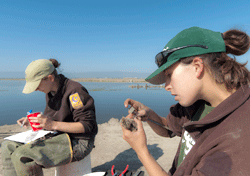 Over the years, the South Bay Salt Pond Restoration Project has benefited from federal funds to support the work of researchers, who are gathering data for our baseline studies and to monitor the impact of restoration and pond enhancement work.
Over the years, the South Bay Salt Pond Restoration Project has benefited from federal funds to support the work of researchers, who are gathering data for our baseline studies and to monitor the impact of restoration and pond enhancement work.
However, in the 2011-12 fiscal year, federal funding through the US Geological Survey has disappeared, as Congress has focused its attentions on trimming federal expenditures.
Here's the picture:
Federal Funding for Salt Ponds Science through USGS
| Fiscal Year |
Total Funding |
| 2008-09 |
$500,000 |
| 2009-10 |
$500,000 |
| 2010-11 |
$1 million |
| 2011-12 |
$0 |
How has this impacted the Project? The funding cutback came at a critical point, after we completed a busy year of wetlands restoration work, and scientists needed to be out monitoring how these changes impacted the environment. Pond SF2 was breached in September, 2010, and Pond A6 shortly afterwards, in December of that year.
"The time to start to collect post-restoration effects data would have been this year, said Project Lead Scientist Laura Valoppi. "So the loss of USGS Research Augmentation funding happened at a critical time, and we have lost the opportunity to understand how these areas, which are critical for shorebird foraging, have been either benefited, or adversely impacted, by the restoration activities immediately after restoration."
The work that scientists had been doing included:
- Bathymetric surveys to measure erosion
- Bird surveys
- Benthic invertebrate surveys
- Sediment flux
- Mercury studies
Since that time the Project has found a limited amount of non-federal funds to support limited bathymetry and mercury work in the Alviso area after the breaches, but has not obtained any funding to support work in the Ravenswood area.
Though we have lost the opportunity to understand what happens to these shoal areas right after opening/breaching of ponds occurs, there is still considerable value to conducting these studies in the ensuing years, as it is expected that there will continue to be changes in the shoals over time after the breach. Given the current federal spending concerns, the outlook does not appear to be favorable for obtaining renewed funding from this source.
Faces of the Restoration:
John Rusmisel
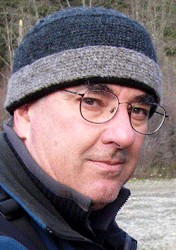 John Rusmisel has managed the Alameda County Mosquito Abatement District since 1994, and worked there since 1977. He has been an active stakeholder with the Project, working to ensure that restoration takes place in a way that won't cause mosquito problems.
John Rusmisel has managed the Alameda County Mosquito Abatement District since 1994, and worked there since 1977. He has been an active stakeholder with the Project, working to ensure that restoration takes place in a way that won't cause mosquito problems.
- How did you get interested
in this field?
I was a botany major at San Jose State. I was interested in plant pathology, and insects are a major cause. I started in agriculture, in pest control, as an advisor. It was seasonal work. I was going to go to grad school at UC Davis when I met my wife. She wouldn't marry me until I got a full-time job, so I looked for full-time work. Eventually, I ended up applying for a job at the Mosquito Abatement District.
- What is the Mosquito Abatement District's interest in the South Bay Salt Pond Restoration Project?
We were brought in as one of the stakeholders. These ponds that are being restored, they don't produce mosquitoes now. They are hypersaline, and mosquitoes don't like that environment. Historically, these areas were salt marshes and did produce mosquitoes. Our district was formed in 1930 to combat salt marsh mosquitoes. We are very interested in seeing that when these ponds are restored back to salt marshes, that they don't become a mosquito issue.
- How does it affect mosquitoes if a salt marsh is opened up?
If it has really good water flow, if you have a really big opening, and water comes into all areas every day and scours it out, you usually don't get mosquitoes in that situation. By participating in the meetings, and interacting with the land managers on a planning process, we can work towards that. The managers' ability to manipulate the water level quickly is something that helps us.
- What sort of mosquito problems do we have along the Bay?
The big problem we have is the summer high tide in August, because it pushes back into areas that don't get a lot of water, and that have mosquito eggs. These mosquitoes are day-biters and they like grassy areas. Sometimes we have to do extra work at this time of year.
Another issue is in areas by the levees along the Bayfront with pickleweed. If the levee is blown out, and there is a lot of rain, the marshes produce a nasty mosquito, Aedes squamiter. It flies up to 20 miles, bites during the day, and can bite through jeans. During certain times of the year before abatement, people couldn't recreate, crops couldn't be harvested, and real estate couldn't be sold because of the mosquitoes. We say that pestiferous, or annoying, mosquitoes are a public health issue. If you have to shut down a school, or people can't come to a park, it's a public health issue, from our perspective.
- What about mosquitoes that carry disease, such as West Nile virus. Are they an issue along the Bay?
There is one species that will come into slightly brackish water and is a vector for West Nile virus and encephalitis. West Nile virus is interesting - it arrived in New York in 1999, and four years after, we saw it in California. It's been quiet for the last few years, and there have been no locally acquired cases in Alameda County.
- How do you work to prevent disease-carrying mosquito populations?
Our program is 99% larval control - we are treating the larvae so they don't get to the flying stage. With our environmental community that we have here, you can't think of dewatering marshes or creeks. We can't just plant mosquitofish, which can be a threat to listed species like red-legged frogs and tiger salamanders. We will only put them in fish ponds or neglected swimming pools. So we pretty much use larval control. We use several bacterial products, as well as a growth hormone: methoprene, a lab-made hormone that keeps mosquitoes in the larval stage. The toxicity to other animals and humans is extremely low. People ask us, "Are you spraying?" They mean: are we killing adults. We use maybe a pint of adulticide per year, mainly to test the machines. It's extremely low use. If we had West Nile virus in Pleasanton or Livermore, we would need to use it.
- What are some of your most unusual experiences on the Bay?
I remember seeing a great blue heron at the mouth of Sulphur Creek in Hayward, eating a muskrat. And the muskrat was not willing to participate in that. The first time I ran into short-eared owls out in the marsh, crouched in the pickleweed -- they would take off, with a 5- to 6-foot wingspan. That was a pretty magnificent bird. Also historical things. A lot of the wood in the marshes is from the 1906 earthquake and fire, and everything below that came from the 1800s. You see the old landings. At the Marsicano Salt Pond north of Highway 92, I found some Asian pottery - you learn there were a lot of Chinese people working there.
People used to shoot at us out in the marsh. Poachers would be out there and they would shoot at any official-looking vehicle. The changes I've seen during my time here - it used to be all locked up and inaccessible to the public. Now, you see people walking, and riding their bikes. You didn't used to see people out there.
- What do you like to do when you are not controlling mosquitoes?
I'm going to be retiring next year. My wife and I plan to move to Ashland, Oregon. My wife is a violinist and likes the culture. My main hobby is applied aquatic entomology, otherwise known as fly fishing, and Oregon is a good area for that.
I used to do a lot of rock climbing - my wife and I met when I was teaching a rock-climbing class. I stopped in 1992 after I crashed and burned. I also like to look for gold - I belong to gold clubs, and the Gold Prospector's Association of America. And I got into ballroom dancing when my daughter was getting married and I needed to dance with the bride. My wife and I used to dance competitively. A lot of mosquito people hassle me about it.
|


 With the scrape of an excavator's bucket, a Department of Fish and Game contractor September 13 began the process of returning 630 Eden Landing acres to their origins as vegetated wetlands.
With the scrape of an excavator's bucket, a Department of Fish and Game contractor September 13 began the process of returning 630 Eden Landing acres to their origins as vegetated wetlands.  A crowd of Project managers, partners, regulators and friends cheered that day as a flood of water from Old Alameda Creek heaved across the gypsum-coated bottom of Pond E8A. Carl Wilcox, DFG Bay Delta Region Manager, spoke about the state's substantial contribution to buying the 15,100 Project acres from Cargill; it contributed $72 million of the $100 million purchase price from Proposition 40 and Proposition 50 bond funds. The Eden Landing breach construction was partly funded by stimulus funds - American Recovery and Reinvestment Act (ARRA) grants provided by the National Oceanic and Atmospheric Administration (NOAA).
A crowd of Project managers, partners, regulators and friends cheered that day as a flood of water from Old Alameda Creek heaved across the gypsum-coated bottom of Pond E8A. Carl Wilcox, DFG Bay Delta Region Manager, spoke about the state's substantial contribution to buying the 15,100 Project acres from Cargill; it contributed $72 million of the $100 million purchase price from Proposition 40 and Proposition 50 bond funds. The Eden Landing breach construction was partly funded by stimulus funds - American Recovery and Reinvestment Act (ARRA) grants provided by the National Oceanic and Atmospheric Administration (NOAA). On June 1, the tidal waters of Alviso Slough flowed for the first time in decades into 1,400 acres of ponds near Alviso, when Pond A8 tidal gates were opened for the first time. Managers opened one of the eight gates at the pond, which is connected to ponds A7 and A5. Since that time, scientists have been sampling pond and slough sediments, fish and bird eggs to determine how the change in water flow is influencing methylmercury in the environment. Managers will open the gates wider, if they can do so without causing mercury problems.
On June 1, the tidal waters of Alviso Slough flowed for the first time in decades into 1,400 acres of ponds near Alviso, when Pond A8 tidal gates were opened for the first time. Managers opened one of the eight gates at the pond, which is connected to ponds A7 and A5. Since that time, scientists have been sampling pond and slough sediments, fish and bird eggs to determine how the change in water flow is influencing methylmercury in the environment. Managers will open the gates wider, if they can do so without causing mercury problems.



 Project managers and scientists are excited by the news that the Project's newly restored salt marshes and sloughs are home to a threatened native fish, the longfin smelt (Spirinchus thaleichthys). Scientists caught 61 members of the species while sampling last December (Photo 1). The fish is listed as threatened under the California Endangered Species Act. Once common, it has experienced severe abundance declines within its range. Its abundance in the San Francisco Estuary and Delta has reached record low levels and it may be extinct in some smaller estuaries.
Project managers and scientists are excited by the news that the Project's newly restored salt marshes and sloughs are home to a threatened native fish, the longfin smelt (Spirinchus thaleichthys). Scientists caught 61 members of the species while sampling last December (Photo 1). The fish is listed as threatened under the California Endangered Species Act. Once common, it has experienced severe abundance declines within its range. Its abundance in the San Francisco Estuary and Delta has reached record low levels and it may be extinct in some smaller estuaries.
 Over the years, the South Bay Salt Pond Restoration Project has benefited from federal funds to support the work of researchers, who are gathering data for our baseline studies and to monitor the impact of restoration and pond enhancement work.
Over the years, the South Bay Salt Pond Restoration Project has benefited from federal funds to support the work of researchers, who are gathering data for our baseline studies and to monitor the impact of restoration and pond enhancement work. John Rusmisel has managed the Alameda County Mosquito Abatement District since 1994, and worked there since 1977. He has been an active stakeholder with the Project, working to ensure that restoration takes place in a way that won't cause mosquito problems.
John Rusmisel has managed the Alameda County Mosquito Abatement District since 1994, and worked there since 1977. He has been an active stakeholder with the Project, working to ensure that restoration takes place in a way that won't cause mosquito problems.